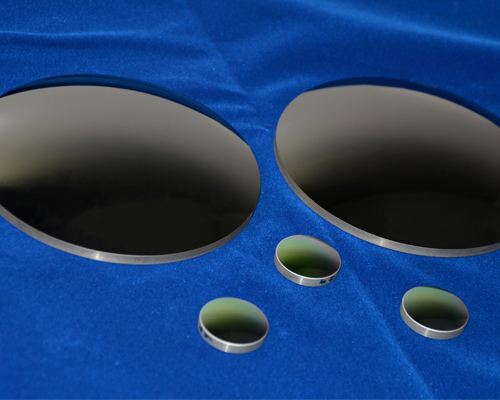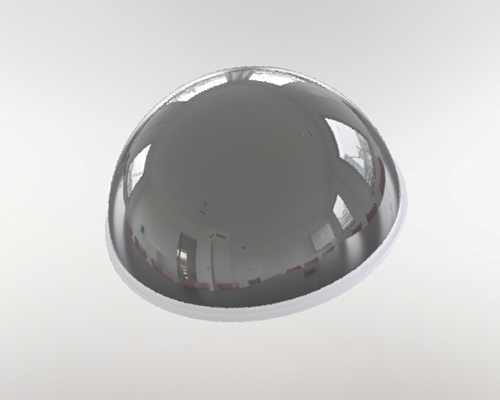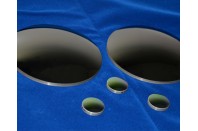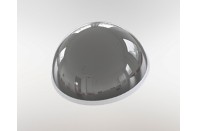The Prospect and Advantages of Infrared Germanium(Ge) Optics
Introduction:
Single Crystal Germanium (Ge) is an optical material of chemical inertia, with its broad transmission spectral region spanning from 1.9 micros to 16 micros, germanium is an excellent and prevalent material for applications in the infrared spectrum. Germanium also exhibits outstanding hardness, high thermal conductivities, and insolubilities in water. Germanium is of extensive usage in infrared thermal imaging and infrared spectroscopes. With distinguished mechanical strength, high thermal conduction, and low absorption at 1060nm, germanium is an ideal substrate material for manufacturing CO2 laser lenses and infrared filter substrates.
The main methods to fabricate single crystal Ge includes the Czochralski method or the Vertical Gradient Freeze, VGF method.
Below are the Material Properties of Single Crystal Germanium(Ge):
1. Transmission Range: 1.8 to 23 μm (1)
2. Refractive Index: 4.0026 at 11 μm (1)(2)
3. Reflection Loss: 53% at 11 μm (Two surfaces)
4.Absorption Coefficient : <0.027 cm-1 @ 10.6 μm (typical)
0.006 cm-1 at 5.6 μm (typical)
<0.005 cm-1 at 2.7 μm
5. Reststrahlen Peak : n/a
6. dn/dT : 396 x 10-6 /°C (2)(6)
7. dn/dμ = 0 : Almost constant
8. Density: 5.33 g/cc
9. Melting Point: 936 °C (3)
10. Thermal Conductivity: 58.61 W m-1 K-1 at 293K (6)
11. Thermal Expansion : 6.1 x 10-6/°C at 298K (3)(4)(6)
12. Hardness: Knoop 780
13. Specific Heat Capacity: 310 J Kg-1 K-1 (3)
14. Dielectric Constant: 16.6 at 9.37 GHz at 300K
15. Youngs Modulus (E): 102.7 GPa (4) (5)
16. Shear Modulus (G): 67 GPa (4) (5)
17. Bulk Modulus (K) : 77.2 GPa (4)
18. Elastic Coefficients : C11=129; C12=48.3; C44=67.1 (5)
19. Apparent Elastic Limit: 89.6 MPa (13000 psi)
20. Poisson Ratio : 0.28 (4) (5)
21. Solubility: Insoluble in water
22. Molecular Weight: 72.59
23. Class/Structure: Cubic Diamond, Fd3m
Germanium single crystal materials could be divided into different categories according to their properties and uses, some are high-resistance germanium for radiation detection, some are germanium with uniform resistance for infrared optics, and some are low-resistance germanium utilized as epitaxial growth of s gallium arsenide in the field of solar cells.
Due to the continuous development, gradual maturities of infrared product-related technologies, and free competition among corporations in the market, which leads to a reduction in costs and prices, infrared-grade germanium crystal becomes more and more commonplace among the public, and the rate of growth with which the civilian market expand is much more significant than that of the defense field. Now more mature applications of optical-grade infrared Ge include the prevention and detection of electrics, in addition to the rapid progress and widespread thermal imaging techniques in fire protection, engineering construction, securities, forest fire prevention, and other fields, the infrared market has huge potential.
The sudden outbreak of the coronavirus pandemic in 2020 underscored the importance of infrared germanium single crystals. One of the common symptoms of coronavirus is that the patient will have a fever, and using an infrared thermometer can realize rapid screening and identification of suspected infectious persons and segregate them. Therefore, infrared thermometers are crucial to winning the battle against the epidemic. Due to the impact of the coronavirus, according to surveillance the current order of germanium single crystal production enterprises has been boosted.
Germanium single crystals for infrared optics are one of the most common infrared optical materials in the world at the current time and are often prepared using the Czochralski method. Its finished components include an infrared germanium lens and a germanium window in the main. Among them, the number of germanium lenses in an infrared germanium lens group varies due to different standards. Armor-grade Infrared germanium lens groups have high precision and technical requirements, often containing more than 6 to 10 germanium lenses each, while commercial-grade infrared germanium lens groups have lower technical requirements, in general containing 2 to 3 germanium lenses. In most circumstances, germanium windows are hired for warfare affairs.
Germanium (Ge) Window:
An optical window is one of the basic optical components utilized to separate the environment into two sides, such as separating the inside and outside of an instrument, so that the inside and outside of the instrument are isolated from each other, protecting the interior of the instruments. A window is a fundamental optical element in the form of a flat plate, which does not change the optical magnification, but affects the optical path. The important parameters of the window are: light transmittance, surface flatness, thickness, parallelism, substrate material, and other properties, and the window with proper specifications can be selected according to the particular application.
The germanium window is well suited for infrared laser applications due to its wide transmission range in the MWIR and LWIR spectrum and opaqueness in the visible range. It blocks the ultraviolet and visible light, making it a devoted IR-transmitters. Germanium can also be used as a long-pass filter for wavelengths greater than 2 microns. In addition, germanium is inert to air, water, alkalis, and various acids. However, the light-transmitting properties of germanium windows are sensitive to temperature, in fact, the absorption of germanium becomes adversely strong at 100 °C, and it achieves complete opaqueness at 200 °C.
 Windows for Thermal Imaging.jpg)
Figure 1. Shalom EO's Germanium (Ge) Window
Germanium (Ge) Lens:
An optical lens is an optical component that diverges (negative lens) or converges (positive lens) light according to its focal length. Optical lenses could be of different shapes and forms, e.g. aspheric and spherical, convex lenses which protrude outward, concave lenses which bend inward, and so on. Optical lenses compose diverse kinds of lenses, including plano-convex/plano-concave lens, bi-convex/bi-concave lens, ball lens/half-ball lens, plano-convex/plano-concave cylindrical lens, rod lens, aspheric lens, etc.
Germanium has the greatest refractive index compared with other infrared materials and low chromatic dispersion, the first trait allows germanium lenses to be capable of contributing a shorter focal length with less amount of lenses and a more compact architecture which otherwise could not be obtained with other material. While the low dispersion means lower chromatic aberration and better image qualities. Germanium lens is an excellent optical component for operations in the IR spectrum (both MWIR and LWIR), such as CO2 laser processing machines with lower power densities. Another aptness of germanium crystal also includes the front optic in infrared thermal imaging cameras, wide-angle lenses, and microscopes. Germanium is an attractive option to manufacture FLIR (Forwarding Looking Infrared) , FTIR (Fourier Transformed Infrared) spectroscopes, and other investigative equipment as well.

Figure 2. Shalom EO's Germanium (Ge) Lens
Germanium (Ge) Dome:
An Optical Dome is a special kind of optical window consisting of two parallel curved faces. Optical domes often take the shape of a hemisphere, but the domes can have other special forms in some specific circumstances as well. Infrared domes are often assigned to affairs related to defense and warfare, such as heat-seeking missiles, protecting the core elements from extreme environments.
Germanium domes allow for longer wavelengths and are ideal for IR applications (in particular for defense and aerospace applications) with their broad transmission band and opaqueness in the visible portion of the spectrum. Germanium domes are leveraged in extensive ranges of IR thermal imaging cameras operating between 2 µm to 14 µm, containing the MWIR (3-5 micro) and LWIR (8-12 micro) thermal imaging wavelength range.

Figure 3. Shalom EO's Germanium (Ge) Dome
Evaluations:
However, some evaluations might be worth considering. He has two defects. First, it’s sensitive to temperature, the transmission rate is about 50% between 2-14 micro at the temperature of 45°C, nevertheless, the transmission rate drops moderately between the interval to 100°C, and plummets at 200°C, the germanium crystal becomes absorptive to the entering radiations that it reaches entire opaqueness. So germanium optics is not a qualified candidate when the working environment is exposed to high temperatures, as engineers or customers we should be aware of this fact. The second drawback of germanium is its high density, which implies undesirable weight issues which the designers should take into count.
Our Infrared Germanium Optics:
Hangzhou Shalom EO is a global supplier of germanium optics, with proficient engineering teams and capable workshops, we provide various germanium optics including Germanium(Ge) Windows, Germanium(Ge) Lens Components, Germanium(Ge) Lens Domes, with a maximum diameter of 300mm and a wide selection of coatings (3-5 micro AR coating, 8-12 micro AR coating, 7-14 micro BBAR coating, DLC coating), the germanium optics could accommodate to both MWIR and LWIR applications, if you are interested, please visit our website to learn more.
Related Products
Tags: Advantages of Germanium(Ge) Infrared Optics



